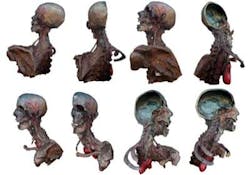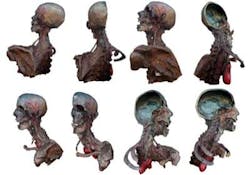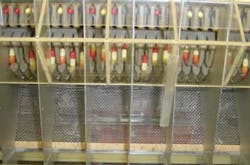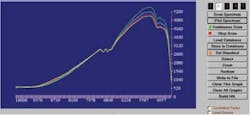PHARMACEUTICAL MANUFACTURING: Pharmaceutical packing system uses IR and visible sensors
Pharmaceutical companies produce millions of tablets, capsules, caplets, and gels each month, each of which must be carefully scrutinized before being packed up and shipped to distributors. During inspection, drug companies must ensure that the correct amounts of medication, with the exact chemical composition and weight, are precisely packed into the appropriate containers.
"Furthermore,” adds Sabrie Soloman, chairman and CEO of American SensoRx (Ridgewood, NJ, USA; www.americansensorx.com), “in packaging such products, companies must also ensure that these containers do not contain foreign objects and are not mixed with drugs of a different type."
To accomplish this automatically, Soloman and his colleagues have developed an automated packaging system known as the FilleRx system, which uses the company's InspectRx Vision and SpectRx NIR Systems that combine near-infrared (NIR) and vision technologies with proprietary software (see Fig. 1).
Once drugs are manufactured, they must be inspected and packaged at relatively high speed. In the design of the InspectRx system, finished product is first loaded into a single hopper that is mounted atop the inspection system. Five vibrating units are then used to shake the tablets under gravity onto a rotational slat cluster that consists of 72 slats, each of which can accommodate 80 cavities (see Fig. 2). “Shaking these vibrating units," says Soloman, “ensures that nearly 100% of the cavities will be filled with product."
To inspect each tablet for the correct chemical composition, a technique known as SpectRx employs NIR spectroscopy to illuminate drugs in each slat with NIR light, and the reflected NIR light is captured and analyzed. To achieve this, light from a halogen lamp source is coupled to a fiberoptic bundle consisting of 80 individual glass fibers, each 1 mm in diameter. "Choosing a particular silica for this fiber ensures that only light in the 800–2300-nm NIR region is transmitted along the silica fibers," says Soloman.
After individual fibers illuminate tablets, capsules, caplets, or gels in each of the 80 cavities, reflected light is digitized by an array of 80 individual thermally cooled indium gallium arsenide (InGaAs) IR detectors. “Thermally cooling these detectors,” says Soloman, "ensures that readings will be stable and not vary due to operating temperature conditions." Data from these detectors are then multiplexed, digitized, and transferred to the system's host PC.
To ensure that the chemical composition of each drug is correct, a fast Fourier transform (FFT) is first performed on the data from each channel. This produces a power spectrum that plots the reflected energy obtained from each tablet at a specific frequency (see Fig. 3). These data are then calculated against a “Golden Standard” previously computed from a known good drug using classical analytical wet chemical methods and additional methods such as gas chromatography, mass spectrometry, and IR spectrophotometry.
"Should a drug profile be outside of a specific tolerance range or indicate that an incorrect drug is present,” says Soloman, "then the machine may be halted and the cause displayed on the operator's interface screen.” However, when a foreign object is detected, the machine may not be halted; rather, the system allows the unwanted product to be rejected at a later process.
After individual tablets are analyzed for chemical composition, they must again be inspected for color, size, weight, any defects that may be present, whether capsules are broken, or whether foreign matter is present. Rather than use 80 separate cameras to perform this task, the InspectRx Vision System employs 10 RMC/TMC-4200GE GigE cameras from JAI (Copenhagen, Denmark; www.jai.com) that are placed over eight segments of each rotating slat. “In this way,” says Soloman, “all 80 tablets can be imaged using 10 cameras.”
As images are digitized by these cameras, they are transferred to the system's host PC using three four-port Intel 9404PR network interface cards (NICs). After regions of interest within each image are isolated, the images of the drugs are analyzed for color composition, whether any chipping or deformation of the drug has occurred, unacceptable weight, or whether any foreign matter is present.
"At the same time," says Soloman, "dimensional measurements of the tablets can be used to calculate the weight of the drug since each drug's specific gravity is already known."
To package these tablets after inspection, a group of bottles is carried along a conveyor system located under the inspection system. After all the bottles are filled to predetermined counts, the bottle lane is released and a servomotor directs other falling tablets to fall into another lane of waiting bottles. "This mechanism," says Soloman, "ensures that the machine can inspect and package the tablets in real time."
All product errors are documented, classified, recorded, and then tracked to the bottle that has received the product with the unwanted object. Then, each bottle containing an unwanted object is rejected and directed to a quarantined location for further analysis.
In addition to performing NIR and visible measurements on each product, software used in the InspectRx/SpectRx system also incorporates neural network software. "Thus," says Soloman, "the operator can enter the tolerance of various dimensions, colors, and flaws and the system will learn the appropriate inspection procedure by analyzing a number of good and unacceptable products.” The results of NIR and visual analysis, combined with the output of the neural network's decision tree are then displayed on the operator interface (see Fig. 4).
Capable of inspecting tablets, capsules, caplets, and gels and packaging them at a rate of 72,000 tablets/min, the InspectRx system is currently deployed at large pharmaceutical companies such as Johnson and Johnson, Avantis, Merck, and Pfizer.




